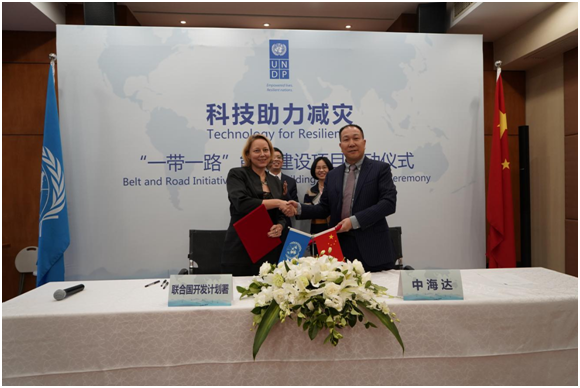Technology for Resilience along the Belt and Road
chinagate.cn by Bai yunzhi,October 25, 2018 Adjust font size:

UNDP and Hi-Target Surveying Instrument Co. Ltd signs Technology for Resilience - Belt and Road Initiative Capacity Building Project.
[Photo by UNDP]
On October 24 in Beijing, the United Nations Development Programme (UNDP) launched an initiative to enhance disaster reduction and response capability in countries along the Belt and Road. This initiative, led by China's National Development and Reform Commission (NDRC) with technical guidance from the Ministry of Science and Technology (MOST), is a concrete follow up to theMemorandum of UnderstandingandtheAction Plansigned between UNDP and the Government of China to integrate the 2030 Agenda for Sustainable Development into the Belt and Road Initiative(BRI).
The project, entitled ‘Technology for Resilience - Belt and Road Initiative Capacity Building Project', aims to provide better tech-based solutions for disaster risk information as part of early warning systems, and for accurate post-disaster damage assessment to enhance disaster readiness and response capacity.
Recognizing the vast potential of the Belt and Road Initiative as an accelerator to achieve the Sustainable Development Goals (SDGs), UNDP has been committed to promoting sustainable development in the Belt and Road countries since 2016. The project aims to facilitate the implementation of sustainable cities and communities, contribute to the building of resilient infrastructure, and foster greater coherence of disaster risk reduction and climate adaptation efforts.
AgiVeres, country director of UNDP China, said,“As one of UNDP’s pilot BRI projects,this projectis expected to bring innovative development solutions to jointly tackle challenges in disaster reduction efforts.”She addedthat the project can potentially be “highlighted as an early successful demonstration for the 2019 Belt and Road Forum.”
Chen Linhao, deputy Director General of the Department of International Cooperation of MOST, observed that this project,based on the principles of mutual benefits and win-win outcomes, would make full use of the innovative BeiDou Navigation System. It will facilitate the sharing of technological resources among BRI countries. In addition, it will provide high-accuracy disaster reduction data services for the promotion of the BRI.
“Such cooperation will bring tangible benefits to countries and regions participating in the Belt and Road Initiative, and therefore is worthy of further scale-up and promotion,” said Zhang Qin, director of the Division of International Organizations of the Department of International Cooperation of NDRC.
Liao Dinghai, president of Hi-Target Surveying Instrument Co. Ltd, a leading remote sensing solution provider in China and a key implementation partner of the project, emphasized the immense potential of technology in strengthening disaster resilience.
Through application analysis, policy recommendations, knowledge sharing and capacity building activities, the project will explore the application of remote sensing, geographic information systems and satellite navigation technology to strengthen the resilience of countries’ urban and rural communities.
